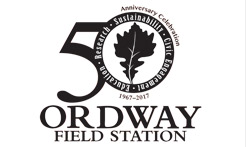
Katharine Ordway Natural History Study Area
Contact
Katharine Ordway Natural History Study Area9550 Inver Grove Trail Inver Grove Heights, MN 55076 651-455-6204 (On Site)
651-696-6230 (On Campus)
andersonm@macalester.edu
Ordway Field Station in the News

Ordway Field Station

The Katharine Ordway Natural History Study Area (Ordway Field Station) is located on the bluffs of the Mississippi River in Inver Grove Heights, Minnesota, 17 miles from campus. The nearly 300-acre site was established in 1967 by Macalester College with the help of a major gift from Katharine Ordway.
The many natural habitats found at Ordway Field Station include:
- tall grass prairie
- oak savanna and woodland
- riparian forests
- seasonal and permanent ponds and springs
- a backwater lake, adjacent to the Mississippi River
These lands have been set aside by Macalester College for education, research, civic engagement, and sustainability including the protection and management of natural environments. Many different Macalester academic departments use this extraordinary facility for teaching and research including the departments of Anthropology, Art and Art History, Biology, Educational Studies, English, Environmental Studies, Geography, Geology, and Media and Cultural Studies.
Any group or individual wishing to visit or utilize the field station for exploratory, teaching, research, management or other activities needs to receive prior approval. Early in the process, please contact Jerald Dosch at [email protected], or Mike Anderson, [email protected].
In the News
Ordway Field Station digital updates
There are two new, exciting online resources for the Ordway Field Station.
1. The 2024 Ordway summer research student crew has launched a blog, “Ordway Field Notes“, with highlights and updates. Take a look to catch up with the happenings at the Field Station including fun nature photos and research updatesa. Watch for regular updates.
2. Want to look at cool trail camera photos taken as part of our summer 2024 research at Ordway? One of the new projects at Ordway Field Station involves looking for deer in trail camera photos to see where they are spending most of their time on the property and what they are doing. This will help us understand what role deer play in shaping the understory plant community at Ordway since overabundant deer can have large impacts on forest ecosystems. Their non-random feeding impacts the abundance, size, and diversity of patrticular understory plants. Help us understand the relationship between white-tailed deer and garlic mustard. We have hundreds of photos to classify and need your help! Click here to get started classifying
Ordway Field Station goes solar
Photovoltaic solar panels were installed on the roof of the building in the fall of 2019. They generate enough electricity to nearly meet the field station’s annual needs. (photo by Matt Meyer)

Capturing the seasons at Ordway
In July 2019, Assistant Professor Mary Heskel installed a new piece of monitoring equipment on the roof the Ordway Field Station building. The ‘PhenoCam’ faces south in a fixed orientation and is programmed to take photos every half hour; each image capturing the same view of Ordway’s three ecosystem types: prairie, deciduous forest, and wetland. By installing a PhenoCam at Ordway, we are now ‘plugged in’ to a network of over 600 cameras that cover a wide range of ecosystem types around the world (https://phenocam.nau.edu/webcam/).
Phenology is the study of biological and environmental processes that are coupled with times of the year – the budburst of new leaves, flowering of prairie plants, the timing of fall leaf color change. Research collected from individual observations and remote sensing methods confirm that seasons are shifting due to changes in climate – often showing progressively earlier spring leaf out and delayed autumn leaf drop. Using image analysis, photos from PhenoCams can provide quantitative estimates of when spring, summer, and autumn occur, and how they may vary with temperature. This is important for ecologists who focus on ecosystem processes and also who think about the timing of animal phenology (i.e. -migration events, emergence of insects from larval state) and how it may or may not align with changes observed in vegetation.
We envision the data from PhenoCam contributing to faculty and student research in Biology and Environmental Studies, and also Math, Stats and Computer Science, as it provides a robust, long-term time-series dataset to model, and Fine Arts and Media Studies, as it offers a fixed, observational perspective on daily and seasonal changes. If you have questions about accessing the data from Ordway’s PhenoCam, please contact Mary Heskel at [email protected].
The PhenoCam images at Ordway can be accessed by anyone here: https://phenocam.nau.edu/webcam/sites/macordway/

Macalester Permanently Protects Open Space Along The Mississippi River
In 2012, Macalester College entered a conservation easement to permanently protect 150 acres of the Ordway Field Station working in partnership with Dakota County, the city of Inver Grove Heights and the Friends of the Mississippi River. Ordway’s director Jerald Dosch called it, “a great win-win situation” and “a wonderful way to mark the 45th anniversary of Macalester’s purchase of the land.”